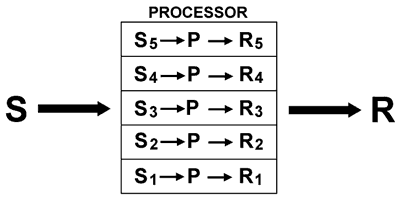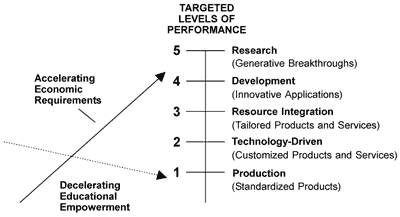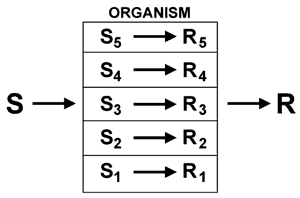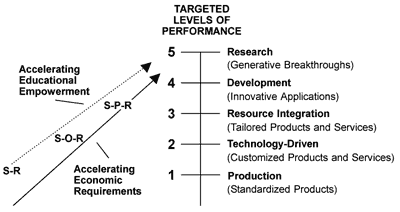Finally, processing in the Age of Ideation incorporated the response repertoires of both conditioned responders and participative learners. The Age of Ideation both defines and is defined by its requirements: a continuous flow of constantly changing information that demands continuous processing. Leaders and performers are defined individually and interdependently by their ability to transform data into effective responses. Frequently the most effective processor is the delivery person, who is at the greatest point of information flow.
In this context, the organism intervenes to process a response that is quantitatively “greater†or qualitatively “better†than the stimuli were calculated to elicit:

Put another way, the processor censors his or her conditioned response in order to process incrementally better responses. For that to happen, though, the processor must have a repertoire of processing responses.
Basically, it is assumed that the individual processor possesses a hierarchy of conditioned responses based on past experiences. What the individual does with this hierarchy constitutes processing (see Figure 4). The individual is able to explore and analyze where he or she is in the stimulus experience. Based on this exploration and analysis, the individual is then able to understand and define where he or she wants or needs to be: in short, to identify his or her goals. Finally, based on understanding those goals, he or she is able to act to develop and implement programs to achieve the goals. Processing is recycled with feedback from acting to stimulate more extensive exploring, more accurate understanding, and more effective acting.

Figure 4. The Responses of Processing Organisms
In living, learning, and working contexts, we can transform raw data into productive information. In a very real sense, after the period of analysis and synthesis of the data, the processor has thrown out his or her own personal “sky hook†in the form of an operational definition of a now-achievable personal objective. In a very real way, processors pick themselves up by their own bootstraps in designing and implementing the individualized programs to achieve their personal objectives.
The difference between human processing and conditioning or learning is profound. Conditioning allows only the highest-order conditioned response to be made reflexively. Learning intervenes to select a more functional response from an expanded hierarchy of responses. Processing explores the experience, understands the goal, and then acts to achieve it. Human processing is qualitatively different from all forms of conditioning, whether reflexive or participative.
In this context, it is assumed that a hierarchy of S–O–R responses are nested within the S–P–R paradigm (see Figure 5). In other words, the individual draws upon a set of acquired S–O–R responses to emit a preferred response to the stimuli.

Figure 5. The S–P–R Generative Thinking Paradigm








